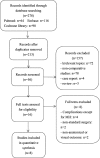Comparative efficacy evaluation of inverted internal limiting membrane flap technique and internal limiting membrane peeling in large macular holes: a systematic review and meta-analysis
- PMID: 31914954
- PMCID: PMC6950886
- DOI: 10.1186/s12886-019-1271-2
Comparative efficacy evaluation of inverted internal limiting membrane flap technique and internal limiting membrane peeling in large macular holes: a systematic review and meta-analysis
Abstract
Background: The purpose of this study was to compare the anatomical and visual outcomes of inverted internal limiting membrane (ILM) flap technique and internal limiting membrane peeling in large macular holes (MH).
Methods: Related studies were reviewed by searching electronic databases of Pubmed, Embase, Cochrane Library. We searched for articles that compared inverted ILM flap technique with ILM peeling for large MH (> 400 μm). Double-arm meta-analysis was performed for the primary end point that was the rate of MH closure, and the secondary end point was postoperative visual acuity (VA). Heterogeneity, publication bias, sensitivity analysis and subgroup analysis were conducted to guarantee the statistical power.
Results: This review included eight studies involving 593 eyes, 4 randomized control trials and 4 retrospective studies. After sensitivity analysis for eliminating the heterogeneity of primary outcome, the pooled data showed the rate of MH closure with inverted ILM flap technique group was statistically significantly higher than ILM peeling group (odds ratio (OR) = 3.95, 95% confidence interval (CI) = 1.89 to 8.27; P = 0.0003). At the follow-up duration of 3 months, postoperative VA was significantly better in the group of inverted ILM flap than ILM peeling (mean difference (MD) = - 0.16, 95% CI = - 0.23 to 0.09; P < 0.00001). However, there was no difference in visual outcomes between the two groups of different surgical treatments at relatively long-term follow-up over 6 months (MD = 0.01, 95% CI = - 0.12 to 0.15; P = 0.86).
Conclusion: Vitrectomy with inverted ILM flap technique had a better anatomical outcome than ILM peeling. Flap technique also had a signifcant visual gain in the short term, but the limitations in visual recovery at a longer follow-up was found.
Keywords: Internal limiting membrane peeling; Inverted internal limiting membrane flap technique; Large macular hole; Meta-analysis.
Conflict of interest statement
The authors declare that they have no competing interests.
Figures








References
-
- Velez-Montoya R, Ramirez-Estudillo JA, Sjoholm-Gomez de Liano C, Bejar-Cornejo F, Sanchez-Ramos J, Guerrero-Naranjo JL, Morales-Canton V, Hernandez-Da Mota SE. Inverted ILM flap, free ILM flap and conventional ILM peeling for large macular holes[J] Int J Retina Vitreous. 2018;4(1):8. doi: 10.1186/s40942-018-0111-5. - DOI - PMC - PubMed
Publication types
MeSH terms
Grants and funding
LinkOut - more resources
Full Text Sources
Medical

